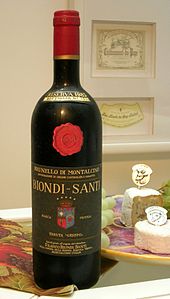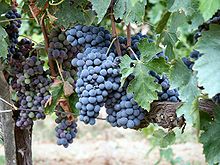Brunello di Montalcino
The Brunello di Montalcino is one of the most famous red wine provenances in Italy . It is named after the municipality of Montalcino in Val d'Orcia , in the south of the province of Siena ( Tuscany ). Along with Barolo and Amarone della Valpolicella, it is one of the most renowned Italian red wines.
history
The Sangiovese clone called Brunello was selected for the first time by Ferruccio Biondi-Santi on his estate "Il Greppo". After that, the Biondi-Santi family practically had a monopoly on this wine for years, but in the first few years it was marketed under the name "Vino Rosso Scelto". The Brunello is no longer an independent variety, but is also referred to in the DOCG regulations as Sangiovese, which is called "Brunello" in Montalcino.
In 1960 the area planted for the Brunello was only 63 hectares and there were eleven bottling companies. The production of Brunello di Montalcino later became the common property in Montalcino, which enabled many small and large companies to also press this wine.
In 1966, the Brunello was one of the first eight areas to receive the status of a Denominazione di origine controllata ; on July 1, 1980 it was the first area with the status of a DOCG . The legal basis was revised for the last time in 2014.
From Brunello di Montalcino 2007, nearly seven million bottles were produced, most for export to the USA (20%), to Germany (14%) and the Switzerland (8%). 251 producers generate an annual turnover of 132 million euros with the Brunello . There are also three million bottles of Rosso di Montalcino and one million bottles from the newly created Sant'Antimo category . Wines with non-resident grape varieties fall into this category and the way for new, modern wines is to be created there.
Manufacturing
Strict DOCG rules apply to the production of Brunello di Montalcino , which are set by the “Consorzio del Vino Brunello di Montalcino”. Cultivation and vinification are only permitted in Montalcino. It is made from a single variety of Sangiovese grape called Sangiovese Grosso or Brunello . The yield is limited to a maximum of 52 hectoliters of wine per hectare . The Brunello is only released for official trade from January 1st of the fifth year following the harvest, it must have been aged in oak barrels for at least two years and be aged in bottle for at least four months . The Brunello di Montalcino Riserva is released for trading from January 1st of the sixth year following the harvest; it must have been aged in oak for at least two years and be aged in bottle for at least six months. Then a full, full-bodied, highly aromatic red wine is created.
Best vintages
The consortium announces an assessment of the quality of the respective vintage every February after the harvest. The best vintages are awarded symbolic five stars. The following vintages have received this assessment to date: 1945, 1955, 1961, 1964, 1970, 1975, 1985, 1988, 1990, 1995, 1997, 2004, 2006, 2007, 2010, 2012 and 2015. The vintage quality of the wines has been increasing since 1992 Tiles designed by artists are documented on the old town hall of Montalcino.
description
- Color: intense ruby red, tending to garnet red after aging
- Odor: characteristic and intense odor
- Taste: tart, warm, tannic, robust and harmonious with a long finish
- Alcohol content: at least 12.5 percent by volume
- Total acidity : at least 5 g / l
- Dry extract : at least 24 g / l
Well-known producers are: Altesino, Barbi, Baricci, Biondi-Santi, Caparzo, Casanova di Neri, Castelgiocondo, Castello Banfi, Ciacci Piccolomini d'Aragona, Col d'Orcia, Costanti, Fanti, Fuligini, La Pieve, Lisini, Loacker Corte Pavone , Pieve Santa Restituta, Pinino, Poggio Antico, Poggio di Sotto, Poggione, Salvioni, Vasco Sassetti, Scopetone, Siro Pacenti, Soldera, Talenti, Vitanza Valdicava, Pian dell'Orino, Val di Suga, Diego di Molinari.
More wines in Montalcino
Rosso di Montalcino DOC
Rosso di Montalcino describes the second wine produced in the Brunello area .
Moscadello di Montalcino DOC
Sant'Antimo DOC
Wine scandal 2008
This wine scandal also Brunellopoli or from the Anglo-American Press Brunellogate called, is a series of events during which several winemakers of the wine fraud had been suspected. The course of events was strongly influenced by the scarce availability of reliable information at the time, as the investigating public prosecutor's office was not allowed to report on the ongoing proceedings and the consortium, probably also because of the feared economic effects, only made very cautious and vaguely worded statements to the public has turned. The scandal was shaped all the more by the speculation made in the press, the rumors spread and the political disputes.
In the spring of 2008, the first rumors arose in the Italian and American press that there were several producers who had been the target of Italian law enforcement. These first suspicions were soon confirmed and it became known that four large companies in the area - Antinori, Frescobaldi, Argiano and Castello Banfi - were suspected of food counterfeiting and the public prosecutor of Siena in April 2008 (public at the Vinitaly wine fair ) several million Had confiscated bottles of 2003 vintage Brunello. Strictly speaking, the allegation was to have violated the production regulations and to have added other international varieties instead of the exclusively permitted Sangiovese grape variety. The process received particular explosiveness and dynamism through a publication by the Italian magazine L'Espresso with the title “Benvenuti a Velenitaly”. The latter is a suitcase word from Veleno (Italian for poison) and Vinitaly (the most important Italian wine fair), which opened in March 2008 when this publication appeared at the same time and was therefore very effective. This article juxtaposed several wine and food scandals of varying severity and reports on 20 accused businesses and possibly several million liters of Brunello confiscated. In May 2008, the responsible US import authorities decided to ban imports of the Brunello.
These events caused a long smoldering conflict to break out in public about the Brunello's strict production regulations. Influential voices - including many producers, cellar masters and Angelo Gaja - suggest loosening the rules and no longer having to make Brunello from 100% Sangiovese in order to be able to place it more successfully and competitively on the international wine markets. Even the then Italian Minister of Agriculture, Luca Zaia , indicated that advances in this direction could be accepted benevolently. On the other hand, opponents of such proposals were concerned with the identity, perhaps even with the continued existence of this wine, which the American wine journalist Karin O'Keefe summed up with the sentence “To be Brunello or not to be Brunello”. After numerous negotiations, the US embargo was largely relaxed in July. In October 2008, the consortium decided with a clear majority of 96% of the votes in favor of maintaining the restrictive regulation regarding the purity of grape varieties for the Brunello. A little later, the regulations of the Rosso di Montalcino were confirmed going in this direction. Also in October, the public prosecutor published a notice stating that the investigation had started in autumn 2007 and that a total of 6.5 million liters of Brunello and 700,000 liters of Rosso di Montalcino had been seized. After being downgraded as IGT or DOC wine by the manufacturers, a large part of the confiscated wine was brought back onto the market in autumn 2008, which in no way can be regarded as an admission of guilt, but rather as an expression of the economic necessity of having to sell the wine in question before all legal issues were finally resolved.
Few people have been convicted of the scandal and hardly any wine counterfeit has been proven. Rather, a lasting effect is the clear positioning of the consortium, which, in the opinion of some wine journalists, has also brought about a reorientation on the part of customers to be critical of the “internationalization” of Brunello.
Brunello in numbers
Vineyard area
| Period | Acreage |
|---|---|
| 60s | 65 ha |
| 70s | 400 ha |
| 80s | 750 ha |
| 1997 | 1245 ha |
| 2008 | 2050 ha |
| 2014 | 1920 ha |
Production quantity (in bottles)
| Period | Bottles |
|---|---|
| 1980/81 | approx. 1.0 million |
| 1990 | approx. 2.0 million |
| 2000 | approx. 3.5 million |
| 2007 | 7.0 million |
In 2017, 69,247 hectoliters of Brunello di Montalcino were produced. This would correspond to 11.3 million bottles.
literature
- H. Ambrosi, E. Dettweiler-Münch, EH Rühl, J. Schmid and F. Schuhmann: color atlas of grape varieties . Eugen Ulmer Stuttgart 1998 ISBN 3-8001-5719-5
- Horst Dippel (ed.): The wine lexicon . S. Fischer Frankfurt / Main 1989. ISBN 3-8112-1114-5
See also
Web links
- Consorzio del Vino Brunello di Montalcino (Italian / English)
- Assessment of the years since 1945 by the consortium (Italian / English), accessed on August 6, 2015
Individual evidence
- ↑ a b c d Disciplinare di Produzione della Denominazione di Origine Controllata (production regulations and description). (PDF) In: ismeamercati.it. November 27, 2017, accessed July 7, 2018 (Italian).
- ↑ Homepage of the consortium (assessment of the years)
- ↑ a b c Kerin O'Keefe: Brunello di Montalcino. Understanding and Appreciating One of Italy's Greatest Wines University of California Press 2012 ISBN 978-0-520-26564-6
- ^ Rumors from Montalcino: vino pugliese spacciato per Brunello?
- ↑ Some See a Wine Loved Not Wisely, but Too Well
- ↑ Steffen Maus: Italy's Wine Worlds - Wine, Vino, Wine . Gebrüder Kornmayer, 2013, ISBN 978-3-942051-18-7 .
- ↑ Benvenuti a Velenitaly
- ↑ Merum magazine 4/08, ISSN 1660-8062
- ↑ a b Journal Merum 5/09, ISSN 1660-8062
- ↑ a b Viticulture in Figures 2018. (PDF) In: VQPRD d'Italia 2018. federdoc.com, accessed on July 6, 2019 (Italian).


